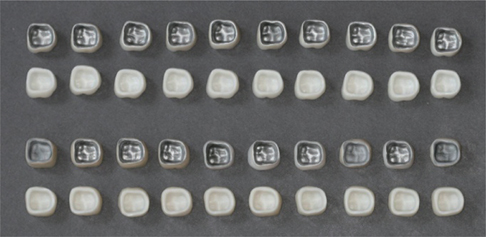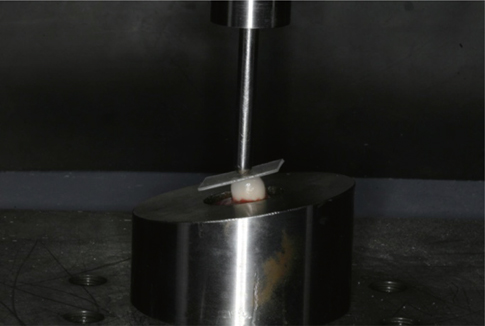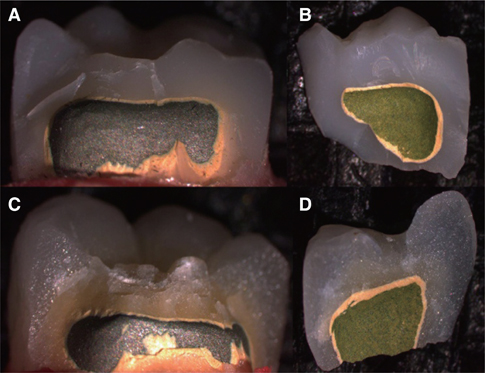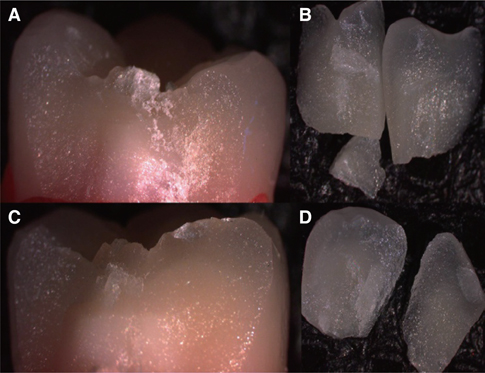J Adv Prosthodont.
2015 Dec;7(6):454-459. 10.4047/jap.2015.7.6.454.
Effect of different veneering techniques on the fracture strength of metal and zirconia frameworks
- Affiliations
-
- 1Department of Prosthodontics, Faculty of Dentistry, University of Ege, Izmir, Turkey.
- 2Private practice, Izmir, Turkey.
- 3Department of Prosthodontics, Faculty of Dentistry, Cumhuriyet University, Sivas, Turkey. drhknkn@hotmail.com
- KMID: 2176620
- DOI: http://doi.org/10.4047/jap.2015.7.6.454
Abstract
- PURPOSE
To determine whether the fracture strengths and failure types differed between metal and zirconia frameworks veneered with pressable or layering ceramics.
MATERIALS AND METHODS
A phantom molar tooth was prepared and duplicated in 40 cobalt-chromium abutments. Twenty metal (IPS d.SIGN 15, Ivoclar, Vivadent, Schaan, Liechtenstein) and 20 zirconia (IPS e.max ZirCAD, Ivoclar) frameworks were fabricated on the abutments. Each framework group was randomly divided into 2 subgroups according to the veneering material: pressable and layering ceramics (n=10). Forty molar crowns were fabricated, cemented onto the corresponding abutments and then thermocycled (5-55degrees C, 10,000 cycles). A load was applied in a universal testing machine until a fracture occurred on the crowns. In addition, failure types were examined using a stereomicroscope. Fracture load data were analyzed using one-way ANOVA and Tukey HSD post-hoc tests at a significance level of 0.05.
RESULTS
The highest strength value was seen in metal-pressable (MP) group, whereas zirconia-pressable (ZP) group exhibited the lowest one. Moreover, group MP showed significantly higher fracture loads than group ZP (P=.015) and zirconia-layering (ZL) (P=.038) group. No significant difference in fracture strength was detected between groups MP and ML, and groups ZP and ZL (P>.05). Predominant fracture types were cohesive for metal groups and adhesive for zirconia groups.
CONCLUSION
Fracture strength of a restoration with a metal or a zirconia framework was independent of the veneering techniques. However, the pressing technique over metal frameworks resisted significantly higher fracture loads than zirconia frameworks.
Keyword
MeSH Terms
Figure
Reference
-
1. Guess PC, Kulis A, Witkowski S, Wolkewitz M, Zhang Y, Strub JR. Shear bond strengths between different zirconia cores and veneering ceramics and their susceptibility to thermocycling. Dent Mater. 2008; 24:1556–1567.2. Akin GE, Kaval ME, Turk T, Akin H. Surface roughness and bond strength of zirconia posts to a resin cement after various surface pretreatments. Photomed Laser Surg. 2015; 33:246–251.3. Akın H, Ozkurt Z, Kırmalı O, Kazazoglu E, Ozdemir AK. Shear bond strength of resin cement to zirconia ceramic after aluminum oxide sandblasting and various laser treatments. Photomed Laser Surg. 2011; 29:797–802.4. Kirmali O, Akin H, Ozdemir AK. Shear bond strength of veneering ceramic to zirconia core after different surface treatments. Photomed Laser Surg. 2013; 31:261–268.5. Zhang Y, Kim JW. Graded structures for damage resistant and aesthetic all-ceramic restorations. Dent Mater. 2009; 25:781–790.6. Goracci C, Ferrari M. Current perspectives on post systems: a literature review. Aust Dent J. 2011; 56:77–83.7. Macedo VC, Anami LC, de Melo RM, Bottino MA, Valandro LF. Effect of the layering technique on bond strength and cohesive resistance of a porcelain-zirconia system. J Adhes Dent. 2014; 16:57–62.8. Ishibe M, Raigrodski AJ, Flinn BD, Chung KH, Spiekerman C, Winter RR. Shear bond strengths of pressed and layered veneering ceramics to high-noble alloy and zirconia cores. J Prosthet Dent. 2011; 106:29–37.9. Choi JE, Waddell JN, Torr B, Swain MV. Pressed ceramics onto zirconia. Part 1: Comparison of crystalline phases present, adhesion to a zirconia system and flexural strength. Dent Mater. 2011; 27:1204–1212.10. Stawarczyk B, Ozcan M, Roos M, Trottmann A, Sailer I, Hämmerle CH. Load-bearing capacity and failure types of anterior zirconia crowns veneered with overpressing and layering techniques. Dent Mater. 2011; 27:1045–1053.11. Bonfante EA, Coelho PG, Guess PC, Thompson VP, Silva NR. Fatigue and damage accumulation of veneer porcelain pressed on Y-TZP. J Dent. 2010; 38:318–324.12. Aboushelib MN, de Jager N, Kleverlaan CJ, Feilzer AJ. Microtensile bond strength of different components of core veneered all-ceramic restorations. Dent Mater. 2005; 21:984–991.13. Ritter JE. Predicting lifetimes of materials and material structures. Dent Mater. 1995; 11:142–146.14. Baldassarri M, Zhang Y, Thompson VP, Rekow ED, Stappert CF. Reliability and failure modes of implant-supported zirconium-oxide fixed dental prostheses related to veneering techniques. J Dent. 2011; 39:489–498.15. Beuer F, Schweiger J, Eichberger M, Kappert HF, Gernet W, Edelhoff D. High-strength CAD/CAM-fabricated veneering material sintered to zirconia copings-a new fabrication mode for all-ceramic restorations. Dent Mater. 2009; 25:121–128.16. Christensen RP, Ploeger BJ. A clinical comparison of zirconia, metal and alumina fixed-prosthesis frameworks veneered with layered or pressed ceramic: a three-year report. J Am Dent Assoc. 2010; 141:1317–1329.17. Aboushelib MN, Kleverlaan CJ, Feilzer AJ. Microtensile bond strength of different components of core veneered all-ceramic restorations. Part II: Zirconia veneering ceramics. Dent Mater. 2006; 22:857–863.18. Eisenburger M, Mache T, Borchers L, Stiesch M. Fracture stability of anterior zirconia crowns with different core designs and veneered using the layering or the press-over technique. Eur J Oral Sci. 2011; 119:253–257.19. Kanat-Ertürk B, Cömlekoğlu EM, Dündar-Çömlekoğlu M, Ozcan M, Güngör MA. Effect of veneering methods on zirconia framework-veneer ceramic adhesion and fracture resistance of single crowns. J Prosthodont. 2014; 10. 15.20. Choi YS, Kim SH, Lee JB, Han JS, Yeo IS. In vitro evaluation of fracture strength of zirconia restoration veneered with various ceramic materials. J Adv Prosthodont. 2012; 4:162–169.21. Nakamura K, Adolfsson E, Milleding P, Kanno T, Örtengren U. Influence of grain size and veneer firing process on the flexural strength of zirconia ceramics. Eur J Oral Sci. 2012; 120:249–254.22. Fahmy NZ, Salah E. An in vitro assessment of a ceramicpressed-to-metal system as an alternative to conventional metal ceramic systems. J Prosthodont. 2011; 20:621–627.23. Schweitzer DM, Goldstein GR, Ricci JL, Silva NR, Hittelman EL. Comparison of bond strength of a pressed ceramic fused to metal versus feldspathic porcelain fused to metal. J Prosthodont. 2005; 14:239–247.24. Ortorp A, Kihl ML, Carlsson GE. A 3-year retrospective and clinical follow-up study of zirconia single crowns performed in a private practice. J Dent. 2009; 37:731–736.25. Näpänkangas R, Raustia A. Twenty-year follow-up of metal-ceramic single crowns: a retrospective study. Int J Prosthodont. 2008; 21:307–311.26. Oilo M, Kvam K, Gjerdet NR. Simulation of clinical fractures for three different all-ceramic crowns. Eur J Oral Sci. 2014; 122:245–250.27. Attia A, Kern M. Influence of cyclic loading and luting agents on the fracture load of two all-ceramic crown systems. J Prosthet Dent. 2004; 92:551–556.28. Joda T, Huber S, Bürki A, Zysset P, Brägger U. Influence of Abutment Design on Stiffness, Strength, and Failure of Implant-Supported Monolithic Resin Nano Ceramic (RNC) Crowns. Clin Implant Dent Relat Res. 2014; 03. 14.29. Chen C, Trindade FZ, de Jager N, Kleverlaan CJ, Feilzer AJ. The fracture resistance of a CAD/CAM Resin Nano Ceramic (RNC) and a CAD ceramic at different thicknesses. Dent Mater. 2014; 30:954–962.30. Sundh A, Molin M, Sjögren G. Fracture resistance of yttrium oxide partially-stabilized zirconia all-ceramic bridges after veneering and mechanical fatigue testing. Dent Mater. 2005; 21:476–482.31. Scherrer SS, de Rijk WG. The fracture resistance of all-ceramic crowns on supporting structures with different elastic moduli. Int J Prosthodont. 1993; 6:462–467.32. Rosentritt M, Plein T, Kolbeck C, Behr M, Handel G. In vitro fracture force and marginal adaptation of ceramic crowns fixed on natural and artificial teeth. Int J Prosthodont. 2000; 13:387–391.
- Full Text Links
- Actions
-
Cited
- CITED
-
- Close
- Share
- Similar articles
-
- Shear bond strength of veneering porcelain to zirconia and metal cores
- Effects of core characters and veneering technique on biaxial flexural strength in porcelain fused to metal and porcelain veneered zirconia
- Biaxial flexural strength of bilayered zirconia using various veneering ceramics
- Shear bond strength of veneer ceramic and colored zirconia by using aqueous metal chloride solutions
- Comparative fracture strength analysis of Lava and Digident CAD/CAM zirconia ceramic crowns





